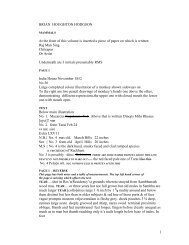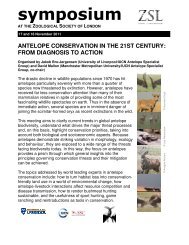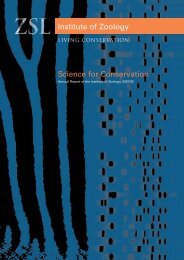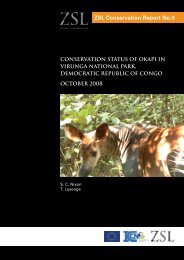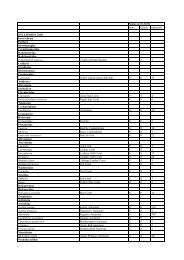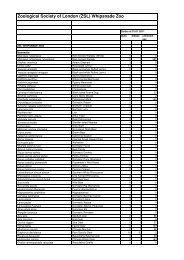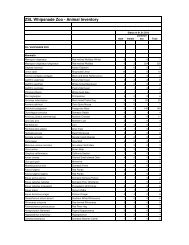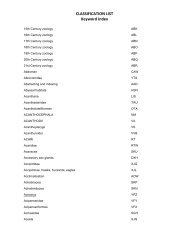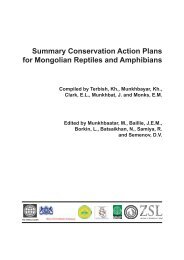MPA Symposium - Zoological Society of London
MPA Symposium - Zoological Society of London
MPA Symposium - Zoological Society of London
Create successful ePaper yourself
Turn your PDF publications into a flip-book with our unique Google optimized e-Paper software.
MARINE PROTECTED AREAS ON THE HIGH SEAS<br />
AN INTERNATIONAL SYMPOSIUM HELD AT ZSL ON 3 AND 4 FEBRUARY 2011<br />
ABSTRACTS OF TALKS<br />
relatively low-cost field work, through platform-<strong>of</strong>-opportunity surveys on the high seas, coastal,<br />
small-boat surveys and recently through autonomous passive acoustic monitoring on continental<br />
shelf waters <strong>of</strong> British Columbia, Canada. Acoustic monitoring can detect the presence <strong>of</strong><br />
vocalizing cetaceans in poorly surveyed areas and seasons, while simultaneously measuring<br />
ambient noise levels, which constitute an important human-use layer for measuring habitat<br />
quality for acoustically sensitive species. Acoustic research now allows estimation <strong>of</strong> acoustic<br />
space that whales lose from chronic shipping and seismic survey noise. Some policy<br />
frameworks, such as Canada’s Species at Risk Act and possibly the EU Habitats Directive, may<br />
allow this science to lead to mitigation through <strong>MPA</strong> planning. Our vision is for a network <strong>of</strong><br />
Quiet <strong>MPA</strong>s. Our recommended approach would (1) map data and gaps, (2) make predictions<br />
about species presence based on habitat suitability, and (3) test those predictions on a randomly<br />
chosen subset <strong>of</strong> regions and species using field data collected from surveys and passive<br />
acoustic monitoring. Based on our experience on the continental shelf, we see our approach as<br />
one that could be transported to the high seas. We cannot consider <strong>MPA</strong>s to be wholly<br />
protected if the management plans ignore acoustic elements, given the importance <strong>of</strong> sound as<br />
the primary modality by which many marine species obtain information about their environments.<br />
14.45–15.15 POSTER SESSION (TEA/COFFEE)<br />
SESSION IV (cont): SOLUTIONS AND THE TRANSLATION OF SCIENCE INTO POLICY<br />
Chair: Kirsty Kemp (Institute <strong>of</strong> Zoology, ZSL)<br />
15.15–15.40 Seamounts are hotspots <strong>of</strong> pelagic biodiversity in the open oceans and<br />
areas <strong>of</strong> special interest for management <strong>of</strong> marine pelagic predators<br />
Telmo Morato 1 , Simon D. Hoyle 2 , Valerie Allain 2 and Simon J. Nicol 2 ,<br />
1 Universidade dos Açores, Portugal, 2 Oceanic Fisheries Program, Secretariat<br />
<strong>of</strong> the Pacific Community, Noumea, New Caledonia<br />
The identification <strong>of</strong> biodiversity hotspots and their management for conservation have been<br />
hypothesized as effective ways to protect many species. There has been a significant effort to<br />
identify and map these areas at a global scale, but the coarse resolution <strong>of</strong> most datasets<br />
masks the small-scale patterns associated with coastal habitats or seamounts. We used tuna<br />
longline observer data to investigate the role <strong>of</strong> seamounts in aggregating large pelagic<br />
biodiversity and to identify which pelagic species are associated with seamounts. Our analysis<br />
indicates that seamounts are hotspots <strong>of</strong> pelagic biodiversity. Higher species richness was<br />
detected in association with seamounts than with coastal or oceanic areas. Seamounts were<br />
found to have higher species diversity within 30–40 km <strong>of</strong> the summit, whereas for sets close to<br />
coastal habitat the diversity was lower and fairly constant with distance. Higher probability <strong>of</strong><br />
capture and higher number <strong>of</strong> fish caught were detected for some shark, billfish, tuna, and<br />
other by-catch species. Our study supports hypotheses that seamounts may be areas <strong>of</strong><br />
special interest for management for marine pelagic predators. We have also evaluated the<br />
existence <strong>of</strong> an association between seamounts and tuna longline fisheries at the ocean basin<br />
scale to identify significant seamounts for tuna in the western and central Pacific Ocean. Our<br />
study identified many seamounts throughout the western Pacific Ocean that may act as<br />
important aggregating points for tuna species. This indicates that management <strong>of</strong> seamounts<br />
For further information, please contact: Publications and Meetings, ZSL, Regent’s Park, <strong>London</strong> NW1 4RY, UK. anne.braae@zsl.org



